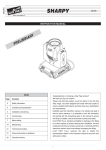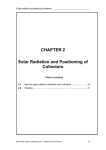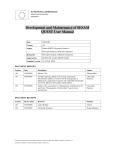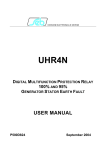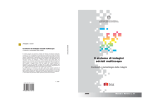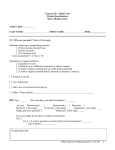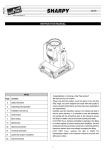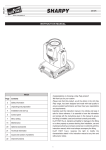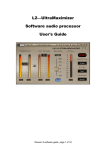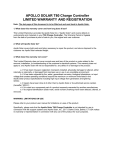Download User and methodological manual
Transcript
MAUSS-R
Multivariate Allocation of Units
in Sampling Surveys
User and methodological manual
Teresa Buglielli, Claudia De Vitiis, Giulio Barcaroli
Servizio Metodi, Strumenti e Supporto metodologico
Direzione Tecnologie e Supporto Metodologico
Istituto Nazionale di Statistica
Introduction........................................................................................................................... 3
1. The methodology implemented in MAUSS...................................................................... 4
1.1. Definition of the methodological problem of allocation............................................. 4
1.1.1. The planning of the survey sampling design ....................................................... 4
1.1.2. One-stage stratified sample design ...................................................................... 5
1.2. Preparation of input files............................................................................................. 5
1.2.1. Strata file.............................................................................................................. 6
1.2.2. File of constraints on maximum expected sampling errors..................................7
1.2.3. Example of construction of input data sets ......................................................... 8
1.3. How to use the output of the system........................................................................... 9
1.4. The multivariate and multi-domain allocation methodology.................................... 10
1.4.1. Multivariate allocation....................................................................................... 10
1.4.2. Multivariate allocation for multiple domains and multiple domain types......... 11
1.4.3. Resolution algorithms.........................................................................................13
2. MAUSS: user manual......................................................................................................14
2.1 Installation.................................................................................................................. 14
2.2 Use of the software..................................................................................................... 15
2.2.1. Starting MAUSS................................................................................................ 15
2.2.2. Main menu..........................................................................................................16
2.2.3. Project definition................................................................................................ 17
2.2.4. Parameters and constraints definition ................................................................20
2.2.5. Allocation........................................................................................................... 23
2.2.6. Reports............................................................................................................... 24
2.3. Input data................................................................................................................... 26
2.3.1. Strata file............................................................................................................ 26
2.3.2. Constraints file................................................................................................... 26
2.4. Produced output ........................................................................................................27
2.5. Work datasets............................................................................................................ 28
2.5.1. List of projects.................................................................................................... 28
2.5.2. Parameters.......................................................................................................... 28
References........................................................................................................................... 29
Appendix: building input file “strata” for MAUSS.............................................................30
Introduction
Mauss is a tool for defining the sampling design for sample surveys on finite
populations. It guarantees optimality criteria, flexibility and easy management for those
who have the responsibility to design and conduct such surveys.
It enables the user, once defined the objectives and the operational constraints of the
survey, to choose the best sampling design between those obtained by adopting different
definitions of the key features of the survey, such as the type of stratification, the
desired accuracy of the estimates, the sample size, the type of domains of study, the
variables of interest.
The use of this software also ensures transparency, standardization and accuracy of the
methods used.
The current version of Mauss is an evolution of previous applications, developed in
SAS. The design and development of these first versions is due to methodologists and
IT developers (including among the first Marco Ballin, Claudia De Vitiis, Piero
Demetrio Falorsi, Germana Scepi; in the second, together with Marco Ballin and Piero
Demetrio Falorsi, also Daniela Pagliuca, Paolo Floris and Roberto Di Giuseppe).
The decision to migrate the SAS version to R was taken as part of a strategy that tends
to reduce the dependence on proprietary software and to ensure full portability of the
tools developed by ISTAT. Moreover, new functions have been added, together with a
more advanced interface. The development of the version described in this manual is
due to Teresa Buglielli (Java interface for project management and execution modules),
Daniela Pagliuca (implementation of the methodology in R) and Giulio Barcaroli
(Chromy algorithm in Fortran).
1. The methodology implemented in MAUSS
1.1. Definition of the methodological problem of allocation
1.1.1. The planning of the survey sampling design
In designing a sample survey, the phase of studying the sampling design and defining
the sample size and its allocation among strata requires the specification of a set of
parameters and information, from which the construction of the input for the allocation
procedure follows. It is necessary to determine:
− the population of interest
− the sampling unit
− the selection frame containing the unit of the population
− the variables of interest
− the parameters which are to be estimated,
− the level at which the estimates have to be produced, i.e. the domains of estimate
− the accuracy to be guaranteed for the estimates at the level of the different
domains
− the auxiliary information useful for the design.
The population of interest must be defined on the basis of criteria that identify precisely
the unit of analysis to be surveyed. Examples of populations are: the set of active
enterprises in Italy with reference to a certain period of time, the population of
households living in Italy in a fixed point in time, the babies born in Italy in a given
calendar year.
The selection frame is the list of the units belonging to the population, containing at
least the information required to identify and contact them. It may also contain auxiliary
information useful for the design phase. In some cases, the frame identifies groups of
units, or clusters, such as a list of families where the family is a cluster of individuals, or
the register of Italian municipalities in which the town is a cluster of households.
The variables to be collected may be qualitative (qualitative answers to questions such
as employment status or perception about a certain phenomenon) or quantitative (such
as income, production or sales). Therefore the parameters to be estimated may be, as in
the first case, the absolute or relative frequencies of response items, or, as in the second
case, averages or totals. Anyway, the software considers as parameters to be estimated
the totals of these variables, corresponding, therefore, to the absolute frequencies for
qualitative items and to the totals for quantitative variables.
The domains of estimates are the sub-populations at the level of which the estimates of
the parameters of interest have to be obtain. These domains must be defined on the basis
of variables available in the frame for each the unit of the population. Examples of
domains are: the region, the province, the region cross-classified with the economic
activity (for enterprises), the age groups. In addition, it is often necessary that the
estimates are produced for more than one type of domain, or to alternative partitions of
the same population.
The precision required for the estimates of interest represents the degree of reliability
that the estimates have to guarantee. It is expressed in terms of the coefficient of
variation (ratio between the standard error of the estimate and the estimate itself), to be
specified for each parameter and each type of domain. For example, it is possible to
require that the estimate of the total turnover of the enterprises at level of region
presents a coefficient of variation not exceeding 10%. It is important to note that for a
certain variable, the coefficient of variation is the same when considering the
estimation of the average and of the total; for qualitative variables it is the same for the
estimation of a relative frequency and the correspondent absolute frequency.
The auxiliary information useful for the planning of the design is generally contained in
the frame or can be obtained from previous similar surveys or from a census. The
auxiliary variables necessary for the allocation are: stratification variables, which are
essential for defining strata and domains of estimate, variables correlated with the ones
of interest, useful for the study of the variability of the variables of interest.
1.1.2. One-stage stratified sample design
MAUSS allows to calculate the sample size and its allocation in the strata for a onestage stratified sample design. To accomplish this sampling scheme, the population
should be divided into strata, accordingly to one or more classification variables known
a priori for all units in the frame.
In a standard stratification, strata may be regarded as the minimum partition of the
population that allows to obtain the domains of estimate as a union of strata (planned
domains). In general, finer strata produce an increase of sample size, given the expected
error; this is due to the necessity to ensure at least one or two sample units per stratum.
In order to illustrate a standard procedure for the construction of the strata, let’s
consider, for example, the case of a business survey aiming at producing estimates
separately for classes of economic activity (as identified by the first four digits of the
classification of economic activities, Nace) and size classes of employees. In this
situation, the strata are defined by the cross-classification of economic activity and size
class of employees.
The allocation of the sample size among strata is achieved following an approach which
is a generalization of the method of Neyman (known as a method of univariate optimal
allocation) and allows to minimize the sample size having established constraints on
maximum expected sampling errors of target estimates, for each type of domain: we can
define this approach as a multivariate and multi-domain allocation. The methodological
aspects are described in detail in Section 5.
It is important to add that some strata can be defined as take-all strata on the basis of a
decision of the responsible of the survey (for example, you may decide a priori to
include in the sample all firms with more than 20 employees).
1.2. Preparation of input files
MAUSS requires that the user provides input data related to the characteristics of the
population under investigation, to the variables of interest for the estimates, together
with the constraints on the expected sampling error of the estimates.
As output, the system produces the sample size per stratum, the expected sampling
errors of all estimates of interest and useful information to evaluate the solution found.
The input information must be provided to the software in two separate data files:
1. the first one contains the stratification of the population, with the number of
units within each stratum, the indication of the domains of estimate and some
estimates of the intensity and variability of the phenomena of interest;
2. the second one contains the constraints on sampling errors, specified for each
variable of interest and each type of domain.
1.2.1. Strata file
The first file have to contain one record for each stratum with the following variables
(rules on names and formats are given in chapter 2 of this manual):
o stratum identifier, h (h = 1, .., H);
o number of units of the population belonging to stratum h, N h ;
o domain code of type 1, type 2, ...., type D to which the stratum h belongs;
o population means, calculated for each stratum and for each one of the P target
variables that will be used to allocate the sample:
m p ,h =
N
h
1
Y p, hj
∑
Nh j= 1
(1a)
where Y pj is the value of the variable y p (p = 1 ,..., P) in the j-th unit of the
population; for qualitative variables, you have to define a dichotomous variable
for each response item, and the mean of the variable corresponds to the relative
frequency f p ,h of the value 1 of the dichotomous variable y p :
m p ,h =
Fp ,h
Nh
= f p ,h
(1b)
where F p ,h is the absolute frequency of the item;
o standard deviations of the P target variables in the population, calculated for
each stratum:
N
s p ,h =
(
h
1
Y p ,hj − m p ,h
∑
( Nh − 1) j = 1
)2
(2a)
for categorical variables, the standard deviation will be calculated as
s p ,h =
f p ,h (1− f p.h )
(2b)
o indication on stratum to be sampled or taken-all (0 to be sampled, 1 otherwise);
o fieldwork costs in the stratum (cost per each interview).
For the construction of the first data set, the main difficulty may arise from the
obtaining of auxiliary information on the variables of interest.
There may be given different possible situations:
3. means and standard deviations can be inferred from the sampling frame, but are
referred to a previous time reference and / or to proxy variables of the variables
investigated;
4. means and standard deviations are obtained as estimates from a previous
occasion of the same sample survey;
5. means and variances are unknown.
In the first case, which occurs for example in the situation of a business survey, when
the turnover or the number of employees is available from the frame (a business
register) for each enterprise referred to a previous year, it is immediate to calculate for
each stratum the required quantities, according to expressions (1a) (1b), (2a) and (2b).
Often, the variables available on the frame are “proxy” of the variables under
investigation and if the correlation between the auxiliary variables and the variables of
interest is high enough, it is possible to ensure a good level of precision on the estimates
of the variables of interest (Cicchitelli et al., 1992).
In the second case, it is possible to obtain the estimates of means and standard
deviations in the population, from sample data of a previous occasion of the same
survey. In this case it is necessary, however, to evaluate the reliability of these estimates
and to use them at a higher level of aggregation than the stratum if they do not exhibit
an acceptable accuracy. In the following, we will show an example dealing with this
particular situation.
The third situation happens when the user does not have any information at all on the
variability of the phenomena of interest because the survey is planned for the first time.
In these cases, it is possible to set the allocation procedure by establishing, for each
domain of estimation, a set of "typical" frequency estimates, in order to cover the range
of variation for all estimates that the survey aims to produce. For instance, if the survey
is used to produce estimates at national, macro-regional and regional levels, you might
desire that the sample is such as to guarantee a sufficient reliability for estimates at least
of 1% at national level, 3% at macro-regional level, and 5% at the regional level. In this
case, the strata will coincide with the most disaggregated domain, namely the region,
using three variables whose means will be constant for all strata:
P1,h = 0.01, P2,h = 0.03, P3,h = 0.05 for each stratum h,
while the standard deviations can be obtained using the (2b).
The software will provide the overall sample size and its allocation among the strata in
such a way that the constraints are respected with regards to sampling error of the
estimates of "typical" frequencies at the level of the different specified domains.
1.2.2. File of constraints on maximum expected sampling errors
The second file should contain one record for each type of domain with the following
variables:
1. code of domain type, d (d = 1, .., D);
2. maximum allowable values of the expected coefficients of variation for each one
of the total estimates of K variables of interest, CV1,... ,CVK.
The preparation of the second file requires the user to specify for each of the estimates
of interest the maximum value of the coefficient of variation allowed for each type of
domains.
It is worth noting that if for a certain estimate it is not needed to guarantee a limit for the
sampling error for a certain type of domain, it is possible to indicate a very high value
of the coefficient of variation for that type of domain, such as, for example, cv = 1.
Regarding the criteria used to set the level of error in the domain, it is common practice
to allocate the sample so that the level is approximately equal for all domains (Sigman
and Monsour, 1995). .
1.2.3. Example of construction of input data sets
The following example is based on the stratification adopted in ISTAT for the survey on
births. The target population consists of mothers of babies born in a given year,
stratified by age groups (5) and regions (21); the interview is conducted two years after
the birth.
The estimation domains are region, macro-region, age group and nation. We assume for
simplicity that the estimates of interest are only two: the relative frequency of women
who were employed before the birth but no longer employed at the time of the
interview, and the relative frequency of women whose children attend the nursery.
Information on the variables of interest in this case is drawn from the data of an
previous survey (case 2 in paragraph 1.2.1). This information was not reliable enough to
be used at stratum level, but only by considering domains defined as cross-classification
of macro-regions and age groups. The variable cost of each stratum is set equal to one
because there is no difference in cost between the different strata. The same for the
variable that indicates the presence of strata to be taken-all: in this survey this indicator
has always been set to zero.
The resulting file has the following structure.
STRATU
M
Domain 1
= Region
Domain 2
=
Age
group
Domain 3 =
Macroregion
Dom 4
=
Nation
Pop
Mean
1
Std
dev 1
Mean 2
Std
dev 2
Cost
Cens
15-24
Piemonte
Piemonte
15-24
North West
1
1000
0.20
0.4
0.45
0.497
1
0
25-29
Piemonte
Piemonte
25-29
North West
1
1600
0.18
0.348
0.5
0.5
1
0
…
…
…
…
…
…
…
…
…
…
…
…
…
…
…
…
…
…
…
…
…
…
…
…
35-39
Sardegna
Sardegna
35-39
Islands
1
700
0.30
0,458
0.2
0.4
1
0
40 +
Sardegna
Sardegna
40 e oltre
Islands
1
300
0.30
0,458
0.25
0.433
1
0
The second file, containing the constraints on sampling errors, has the following
structure.
Domain type
CV1
CV2
Dom1 = Region
0.10
0.14
Dom2 = Age group
0.08
1
Dom3 = Macro-region
0.05
0.08
Dom4 = Italy
0.02
0.03
The values assigned to the coefficients of variation for the two estimates at level of the
four types of domains are only examples, but show how, in general, to the types of
domains with a larger number of values, is given a higher value of the coefficient of
variation.
It can be noted that, as for the second variable is not required to estimate the level of age
groups (DOM2), the bound was set equal to 1.
1.3. How to use the output of the system
The system produces as output: (a) the sample size per stratum, (b) the expected
sampling error for each target estimate in each domain of interest, (c) some useful
statistics for the improvement of the sampling plan.
The sample sizes for each stratum are added to the input dataset of strata, while the
expected sampling errors are reported both in the output dataset and in output tables 7
and 8. The statistics useful for adjusting the allocation solution are shown in Table 5.
The system allows the user to choose the final solution by comparing the results of
several tests, obtained by defining the precision constraints in different ways.
Table 5 is the instrument at the user’s disposal to evaluate how to modify input data,
particularly data in the second input file. This table contains the information useful for
the sensitivity analysis: for each estimate and each type of domain is given the value of
the additional sample size needed to achieve a decrease of 10% of the coefficient of
variation of the corresponding estimate. This number can also be interpreted in the
opposite direction, i.e. as it represents the decrease in sample size that would be
achieved by increasing the error of the corresponding estimate of 10% at the level of
that type of domain.
For example, continuing the example regarding the survey on births, suppose that the
sensitivity of the estimate of the first variable in the first domain type (region) is equal
to 567 units. Because the coefficient of variation of this estimate was set at 10% (CV1 =
0.10), this means that:
o to obtain a reduction in sample size of 567 units is necessary that the value of
CV1 shifts from 0.10 to 0.11, which is equivalent to an increase of 10% of the
expected sampling error;
o to obtain a reduction of 10% in the expected error, 567 units should be added to
the sample.
Using this tool the user is able to make the necessary adjustments to achieve the desired
sample size or, conversely, to achieve the desired expected precision on target
estimates.
1.4. The multivariate and multi-domain allocation methodology
In general, the determination of the sample size of the different strata is functional to the
minimization of the sample variability of the estimates. In the absence of specific
information on the variability in the strata, the objective is achieved through the
proportional allocation; conversely, if this information is available, it is possible to
define more efficient allocations.
In the case of a single variable of interest, being available an estimate of the variability,
one can refer to well-known results for the optimal allocation in the univariate case
(Cochran, 1977); these results are used to determine the sample size with the aim to
minimize variance estimation for a fixed value of the cost function or, conversely, to
minimize costs, having previously established the level of accuracy of the estimates.
The univariate solution is however not suitable for the design of most surveys, which
are usually characterized by a plurality of target estimates. For these surveys, therefore,
it is necessary to deal with the problem of optimal allocation under a multivariate
approach. The following is taken from Falorsi et al. (1998).
1.4.1. Multivariate allocation
In a stratified sample with equal probabilities of selection of units and without
replacement, the variance of the estimator of the total of a generic variable of interest,
yp (p = 1 ,..., P) can be expressed as:
V 'p = V p + V0 p =
H N2
H
∑ n h S 2p ,h − ∑ N h S 2p ,h
h= 1 h
h= 1
(3)
where V 'p = V p 0 + V p is the variance of variable p in stratum h and V0p is the part of
variance not influenced by allocation.
We also define the following cost function:
C ' = C0 + C = C 0 +
H
∑
C h nh
(4)
h= 1
where C0 is the fixed cost of interviewing that does not depends on the sample size nor
on the allocation, C is the variable cost, and Ch (h = 1 ,..., H) the cost per sample unit in
the stratum h.
It is possible to determine the number of units to be assigned to each stratum using two
approaches (Sigman and Monsour, 1995). The first approach consists in minimizing the
product W * C, where
W=
P
∑
W pV p
p= 1
and Wp (p=1,...,P) are weights to be defined. The
solution is found by setting the value of W or C. It is possible that this method does not
work in concrete situations due to the difficulty of specifying non-arbitrary weights.
In the second approach an upper bound V *p is set for each V 'p and the cost function C is
minimized under the constraints V 'p ≤ V *p (p=1,..,P).
10
MAUSS uses the latter approach, adopting a generalization of the solution proposed by
Bethel (1989), that defines a constrained minimum problem with convex objective
function and linear constraints. In particular, we reformulate the quantity C in (4) by
defining:
if n h ≥ 1
1 n
xh = h
∞ ,
otherwise
In this way the expression of the objective function to be minimized becomes:
H
∑
f( x ) =
C h xh
(5)
h= 1
'
*
where x =(x1,..., xH)’. The constraints V p ≤ V p take the form:
H
∑
a p ,h xh ≤ 1
h= 1
, p=1,...,P
(6)
being:
a p ,h =
N h2 S 2p ,h
(V *p − V0 p )
.
(7)
Since the minimization problem of (5) under constraints (6) satisfies the conditions of
*
the theorem of Kokan and Khan (1967), then an optimal solution x exists. Using the
theorem of Kuhn-Tucker (1951), Bethel demonstrates that there exist values λ *p ≥ 0 , so
that the optimal solution takes the form:
x*h =
Ch
*
*
where µ p = λ p
P
∑
P
∑
µ *p a p ,h
p= 1
H
∑
k=1
λ *p , therefore
p= 1
Ck
*
µ
a
∑ p p ,k
p= 1
P
P
∑
µ *p = 1
p= 1
(8)
(9)
To determine simultaneously the optimal values x*h and µ *p it is necessary to resort to
numerical algorithms, such as those proposed in the work of Bethel, which will be
discussed in the following.
1.4.2. Multivariate allocation for multiple domains and multiple
domain types
The solution described in the previous paragraph is related to the case when the
estimates of the parameter of interest have to be provided for the total population. In
11
general, however, sample surveys are intended to provide estimates not only for the
entire population, but also for subpopulations (domains of study) identified by a
partition (or domain type) of the population under investigation. Furthermore, it is often
necessary that the estimates are produced for more than one type of domain, which
identify alternative partitions of the same population. In these cases the sample must be
planned so as to ensure simultaneously the accuracy of the estimates at different
required levels of detail, and this can be achieved by generalizing the solution
previously described.
To illustrate the method of multivariate allocation in the case of multi-domain
estimation, we denote by d (d = 1 ,..., D) the generic type of domain; kd (kd=1,...,Kd), the
generic domain of type d; H k d the number of strata belonging to the domain kd. The
objective function (5) remains unchanged, while the system of constraints can be
redefined as follows:
H kd
H kd
N h2 2
S
−
∑ n p ,h ∑ N h S 2p ,h ≤ V *p ,k d
h= 1 h
h= 1
(p=1,...,P; d=1,...,D; kd=1,..., Kd)
(10)
where V *p ,k d is the upper bound on the sampling variance of the estimate of the total of
variable p for the domain kd.
Similarly to what was done in previous paragraph, the (10) can be written as:
H
∑
a p ,k d ,h xh ≤ 1
(p=1,...,P; d=1,...,D; kd=1,..., Kd)
h= 1
where
a p ,k d ,h =
N h2 S 2p ,hδ k d ,h
H
∑
h= 1
1
N h S 2p ,hδ k d ,h + V *p ,k d
,
(11)
if h ∈ k
d
with δ k d ,h = 0 otherwise
By defining an index r whose values are in correspondence with the values found by
lexicographically ordering the vector identified by three indices (d, kd, p), the system of
constraints becomes:
H
∑
ar ,h xh ≤ 1
h= 1
for r =1,...,R,
D
where R= P ∑ K d
d=1
,
(12)
i.e. a form totally equivalent to (6).
Returning to the (8), and being the conditions of the theorems of Kokan and Khan
Kuhn-Tucker still satisfied, the optimal solution that minimizes (5) under constraints
(12) is:
12
x*h =
Ch
R
H
R
*a
µ
C
µ *r a r ,k
∑
∑
∑
r
r
,
h
k
k=1
r= 1
r= 1
R
R
r= 1
r= 1
(13)
*
*
*
*
where µ r = λ r ∑ λ r with ∑ µ r = 1 .
(14)
1.4.3. Resolution algorithms
The algorithm proposed by Bethel for the calculation of the optimal multivariate
allocation can be generalized to solve the same problem when there are multiple types
of domains. This algorithm comes to the optimal solution iteratively, starting from an
initial one (ν = 1) which coincides with the optimal solution in the univariate case for
the first variable on the first domain (r = 1). Typically with this solution the objective
function assumes a very small value and the remaining constraints (r = 2, .., R) are not
satisfied. In each of the following steps (ν = 2.3,…, ν), the sample size is increased,
increasing the objective function f x(ν ) ≥ f x (ν − 1) in order to satisfy all the constraints.
Bethel shows that the algorithm converges and, therefore, µ* e x* can be identified
simultaneously so that 0 ≤ f x (ν ) ≤ f ( x * ) .
( ) (
)
( )
The computational complexity of this algorithm, especially in the case of multiple
domains of study, led to the use of the algorithm proposed by Chromy (1987) which is
of more immediate implementation and seems to converge towards the optimal solution
more quickly.
To illustrate this algorithm, let A= {ar ,h } be the matrix of size R and H, whose elements
are defined by (11) and ar be the r-th row of A. The Chromy algorithm is an iterative
algorithm, whose first step consists in computing the value of x according to (13), by
setting each element of µ equal to 1/R. If this solution satisfies all the constraints, the
( ν)
algorithm stops. Otherwise, the algorithm calculates x in correspondence of vector µ
whose generic element is provided by the following expression
(ν )
µr
(
where x µ (ν
(ν − 1 )
= µr
− 1)
(a r x ( μ ( ν − 1 ) ) 2
R
∑
(ν − 1 )
µr
r= 1
(a r x ( μ ( ν − 1 ) ) 2
1≤ r ≤ R
(ν)
(15)
) denotes the value of x, obtained on the basis of (13) putting µ = µ (ν − 1) .
Since these algorithms do not ensure that in the optimal solution satisfies nh ≤ N h ,
MAUSS contains a procedure for the iterative reallocation that sets as take-all strata the
strata in which nh > N h and recalculate the sample size under the changed conditions.
13
2. MAUSS: user manual
2.1 Installation
Microsoft Windows.
The minimum hardware requirements for Mauss-R are:
•
•
RAM: 512MB
Disk Space: 5MB
Also need to be installed on your PC:
• Java 2 Runtime Environment version 6 or higher
(http://java.sun.com/javase/downloads/index.jsp)
• R
Environment
version
7.0
or
higher
project.org/bin/windows/base/)
(
http://cran.r-
The environment variable PATH must point at the programs java.exe and r.exe.
To change the variable PATH:
Start Settings Control Panel System Advanced Environment variables
Now select the PATH variable and click on the Edit button. Add here, at the beginning
of the string, the path to the folder that contains the java.exe file and the folder that
contains
r.exe
separated
by
";".
For example:
PATH=C:\Programmi\Java\jre1.6.0_03\bin;C:\Programmi\R\R-2.7.1\bin;
C:\WINDOWS\system32;C:\WINDOWS;C:\WINDOWS\System32\Wbem;
Installation
To install the software you need to download the file setup_MaussR.exe on your PC and
run it.
14
2.2 Use of the software
2.2.1. Starting MAUSS
From Windows Menu:
Start ->Programmi->mauss->MaussR
From the desktop:
double-click on the icon
15
2.2.2. Main menu
The MAUSS-R menu contains the following functions (see fig. 1):
Figure 1 – Main Menu
•
•
•
•
•
File – Definition of a project: creation of a new project, opening an existing project,
closure of the project in progress and quit the application.
Definition – Changing the parameters and the constraints used to compute the optimal
allocation.
Allocation – Running the optimal allocation by the method of Bethel for the current or
for all versions of constraints file.
Report - View the results and prints.
Help - Display the online help.
16
2.2.3. Project definition
In MAUSS-R, a "project" is individuated by the name of the folder in which all data files
generated by the application will be located. Other relevant information are the names of
input files prepared by the user:
1. the first one gives the population size and mean and variance for each variable of
interest for each stratum.
2. the second one includes, for each domain, the coefficients of variation for the
estimates. For a description of the two files see below the section "Data file
description".
Figure 2 – File menu
Functions (see fig. 2):
• New project: : Inserting a new project.
Choosing the item New project, the window shown in Figure 3 will be open. This window
allows to choose the folder in which the result files will be written and the two input
files.
17
Figure 3 - New project
File names may be entered directly into the text box or can be selected using the File
Manager clicking on the Browse button.
After giving the confirmation (OK), the procedure checks the data entered and, if
everything is right, prepares the environment: sets the version number of the constraints
to 1 and creates the BethV1 subdirectory of the work folder where copies the constraints
file and where will write the results of the optimal allocation for the first version of
constraints.
If an old project was defined in the chosen folder, the system asks if you want create a
new project. If so, it cleans the folder by moving all the results of prior process in a subfolder named backupNNNNNN where NNNNNN is a number that represents the
system time in milliseconds. Otherwise it closes the window without defining the
project that can be opened using the Open Project function.
•
Open project: Opening an existing project
In this case, the user can choose the version of the file of the constraints and the
project, from a list of already defined projects. The fields for the choice of the folder
and of the two input files will automatically written and can not be changed.
18
Figure 4 - Open Project
•
Close: Closing the current project.
•
Exit: Quit the application.
19
2.2.4. Parameters and constraints definition
Figure 5 Definition Menu
Functions (see fig. 5):
•
Parameters: Definition of parameters.
It is possible to modify the following parameters (see fig. 6):
o
Minimum number of units per strata (default = 2).
o
Maximum number of iterations (default = 25) of the general procedure. This
kind of iteration may be required by the fact that when in a stratum the number
of allocated units is greater or equal to its population, that stratum is set as
“census stratum”, and the whole procedure is re-initialised.
o
Maximum number of iteration in the algorithm of Chromy (default = 200);
o
Epsilon (default = 1e-11): this value is used to compare the difference in results
from one iteration to the other; if it it is lower than “epsilon”, then the
procedure stops.
20
Figure 6 – Parameter Definition
•
Constraints: Definition of constraints.
This function allows (see fig. 7):
o
Choose the version of constraints.
o
Modify the values of constraints in the table.
o
Insert a new version of the file.
Figure 7 - Definition of constraints
You can change a coefficient of variation by double-clicking the cell, writing the new
value and moving to the next box with the TAB key or the mouse.
21
WARNING! The change is recorded only if the cursor is positioned in a cell different
from the cell that contains the changed value.
The Update button writes the constraint's table on the current version of the file.
The button Insert changes the version number of the constraints file, creates a
new sub-folder of the working directory with the name BethVn, where n is the new
version number, and inserts the data displayed in the table to a new file of constraints.
It is possible change the current version of the current constraints file using the
list-box Version.
22
2.2.5. Allocation
This menu runs the function that computes the multivariate optimal allocation for
different domains of interest in a stratified sample design. This function is an extension
of Bethel methodology with Chromy Algorithm.
Figure 8 - Allocation Menu
Functions (see fig. 8)
• Current version: Calculating optimal allocation for the current version.
•
All versions: Calculating optimal allocation for all versions of the file of constraints.
23
2.2.6. Reports
Reports concerning general information about population and results of Bethel method are
available.
Figure 9 – Report Menu
Functions:
• Population: Analysis of the population.
Figure 10 – Information on population
24
In this window (see fig. 10) there are two tables containing information about population. In
the first there are general information as the number of population units, the number of
strata and of different domains. The second is a table of population and number of strata by
domain for every kind of domain.
These reports are written in Bethel_Report_Pop1.xls file.
•
Allocation Results
In this window (see fig. 11) there are three tables containing information about optimal
allocation.
Comparison between allocation results table: for each stratum, the sample size obtained
by the optimal allocation of Bethel for the different versions of the file of constraints. This
report is written in BethelResults.xls file.
Allocation results table: for each, stratum, the Bethel sample size, computed with the
current version of coefficient of variation, is compared with the dimension of population
and the values obtained with proportional and equal allocation.
This report is recorded in the Bethel_Report1.xls file.
Figure 11 – Allocation results
Sensitivity: Coefficient of variation and sensitivity
In this table, expected and actual coefficients of variations and sensitivity to a variation
of 10% of the desired precision are reported.
This report is recorded in the Bethel_Report2.xls file.
25
2.3. Input data
2.3.1. Strata file
File Format: tab-delimited (.txt).
Header: The first line of the file must contain the names of the variables specified
in the table in any order. The file can also contain other variables.
Data: A record for each stratum with, at least, the information listed in the table (variables
COST and CENS can be omitted). Data may also be related to other variables not
involved in calculating optimal allocation.
Variable name
STRATO
N
DOM1, DOM2, …,DOMp
M1, M2, …, Mn
S1, S2, …, Sn
COST
CENS
Description
Stratum code.
Number of population units in the stratum.
Domain codes (1…p)
Means of n variables in the population
Standard deviation of n variables in the
population
Survey unitary cost for stratum. Default=1
Indicator of stratum coverage:
1 = stratum to be censused.
0 = stratum to be sampled.
Default = 0.
Format
A
N
A
N
N
N
N
2.3.2. Constraints file
File Format: tab-delimited (.txt).
Header: The first line of the file must contain the names of the variables specified
in the table in any order. The file can also contain other variables.
Data: Coefficients of variation for all domains. A record for each type of domain
that contains the information about the variables listed in the table. Other not
relevant
variables
can
be
present.
Variable name
DOM
CV1, CV2, …, CVn
Description
Format
Type of domain code.
A
Planned coefficient of variation for n N
variables.
26
2.4. Produced output
OUTPUT FILE
File Format: tab-delimited (.txt).
Filename: Bethel_campio.txt
Folder: Sub-folder in the working directory for the version.
It is a copy of the strata input file to which is appended the variable CAMP containing
the result of Bethel's optimal allocation.
27
2.5. Work datasets
2.5.1. List of projects
File Format: tab-delimited (.txt).
Filename: progetti.txt
Folder: Sub-folder $HOME/.Mauss2 in the working directory for the version.
Variable name
folder
strati
vincoli
versione_corrente
ultima_versione
data_progetto
Description
Type
Working directory
A
Name of strata file
A
Name of constraints file
A
Progressive number of the last used N
version of the project
Progressive number of the last used N
version of the constraints
Date of creation of the project
YYYY/MM/DD
HH:MI
2.5.2. Parameters
File format: delimited file (with “;” delimiter character)
Filename: savePar.csv
Folder: Working directory
Variable name
minstrato
maxiter
maxiterChromy
Epsilon
Description
Minimum number of units per stratum
Maximum number of iterations
Maximum number of iterations (Chromy)
Format: 1e-11
Type
N
N
N
N
28
References
BELLHOUSE D.R. (1984), “A Review of Optimal Designs in Survey Sampling“,
Canadian Journal of Statistics, Vol.12, pp.53-65
BETHEL J. (1989), “Sample Allocation in Multivariate Surveys”, Survey Methodology,
15, pp 47-57.
CAUSEY B.D. (1983), “Computational Aspects of Optimal Allocation in Multivariate
Stratified Sampling”, SIAM Journal of Scientific and Statistical Computing, Vol.4, pp.
322-329
CICCHITELLI G., HERZEL. A., MONTANARI G.E. (1992), “Il Campionamento
Statistico”, Il Mulino.
COCHRAN W.G. (1977), “Sampling Techniques”, 3rd ed., Wiley, New York
CHROMY J. (1987), “Design Optimization with Multiple Objectives”, Proceedings of
the Survey Research Methods Section, American Statistical Association, pp.194-199.
DAYAL S. (1985), “Allocation of Sample Using Values of Auxiliary Characteristic”,
Journal of Statistical Planning and Inference, Vol.11, pp.321-328.
DI GIUSEPPE R., GIAQUINTO P., PAGLIUCA D. - (2004), "MAUSS: un software
generalizzato per risolvere il problema dell'allocazione campionaria nelle indagini
Istat", Istat, Collana Contributi, n. 7/2004
FALORSI P.D., BALLIN M., SCEPI G., DE VITIIS C., (1998) “Principi e metodi del
software generalizzato per la definizione del disegno di campionamento nelle indagini
sulle imprese condotte dall’ISTAT”, Statistica Applicata Vol. 10, n.2
KISH L. (1965), “Survey Sampling”, Wiley, New York.
KOKAN A.R., KHAN S. (1967), “Optimum allocation in multivariate surveys: an
analytical solution”, Journal of the Royal Statistical Society B., No. 29, pp. 115-125.
KUHN H.W., TUCKER A.W. (1951), “Nonlinear Programming”, Proceedings of II
Berkley Symposium Mathematical Statistics and Probability.
SARNDAL C.E., SWENSSON B., WRETMAN J. (1992), “Model Assisted Survey
Sampling”, Springer Verlag, New York.
SIGMAN R.S., MONSOUR N.J. (1995), “Selecting Samples from List Frames of
Businesses”, in Cox B.G., Binder D.A. Chinappa B.N., Christianson A., Colledge M.J.,
Kott P.S. (eds) Business Survey Methods, Willey, New York.
29
Appendix: building input file “strata” for MAUSS
In this appendix we show how it is possible, using a function of the R package "Mauss"
(used by the software presented in this manual), to build one of the inputs required by
Mauss, the one relating to the strata that characterise the frame of reference population .
To check the availability of the package "Mauss", in R environment you must run the
command:
> library(mauss)
If the package has not been installed (but it should, as it is contextual to the MAUSS
software installation), you must install it as a priority.
To use the function buildStrataDF, which allows for the construction of the input
file "strata" required by MAUSS, two options are given:
1. the frame, from which the sample will be selected, contains information about the
target variables (the Y) survey (this is the case, for example, of frames containing
census data or administrative data);
2. the frame does not contain such data: it will then need to calculate, for each
stratum, the estimates for means and root mean square deviations of the Y’s, using
different sources (for example, a previous round of the same survey, or different
surveys with proxy estimates).
In the following, we examine both possibilities.
1. Availability of information concerning Y’s in the frame
In the R environment, a dataframe named “frame” contains the following information:
1.
2.
3.
4.
5.
a unique identifier of the unit (no restriction on the name, may be “cod”);
the (optional) identifier of the stratum to which the unit belongs;
the values of m auxiliary variables (named from X1 to Xm);
the values of p target variables (named from Y1 to Yp);
the values of the domains of interest for which we want to produce estimates
(named “domainvalue”).
For example:
> frame <- read.delim(“frame.txt”)
> head(frame)
cod domainvalue
strato X1 X2 X3
Y1
Y2
1 100
4 4so1b4sau1 2 4 1 3283.2128 1167.9092
2 200
4 4so1a6sau1 1 6 1 1997.4587 614.9569
3 300
4 4so1a6sau1 1 6 1 569.9164 1498.6392
4 400
4 4so1a8sau1 1 8 1 1786.8751 1051.1127
5 900
4 4so1a5sau1 1 5 1 910.3036 808.0705
6 1200
4 4so1b1sau2 2 1 2 3273.3433 969.6291
30
If this information is available, it is possible to use the function buildStrataDF in
this way:
> buildStrataDF(frame)
The function takes as argument the name of the single frame, and writes in the working
directory the data frame containing information about strata (named "strata.txt"),
structured as follows:
> head(strata)
1
2
3
4
5
6
strato
N
M1
M2
1*1*1 156 623.4663 843.2696
1*1*2 68 1062.4884 867.4100
1*1*3 17 937.9182 905.4114
1*1*4 20 1377.0881 787.4087
1*1*5
3 1614.3787 660.2262
1*1*7
2 1809.0502 1324.6433
S1
469.92162
504.12793
505.92665
359.69583
20.33451
185.48919
S2 cost cens DOM1 X1 X2 X3
355.71351
1
0
1 1 1 1
366.40575
1
0
1 1 1 2
327.92656
1
0
1 1 1 3
394.92049
1
0
2 1 1 4
250.12945
1
0
2 1 1 5
86.84577
1
0
2 1 1 7
2. Availability of information from sources other than the frame (other surveys)
Conversely, if there is no information in the frame regarding the target variables, you
must build the data frame "strata" from other sources, such as from a previous round
of the same survey, or from other surveys.
In this case, assuming the information available is contained in a file named
“samplePrev.txt”, we need to read the data by running:
> samp <- read.delim(“samplePrev.txt”)
In addition to naming constraints introduced above, this feature requires that a variable
named "weight" is present in the data frame "samp".
At this point you can perform the same function as already seen above:
> buildStrataDF(samp)
The result is much the same than the previous case: the function writes out in the
working directory the strata file, named “strata.txt”.
Note that in all cases, for each target variable Y, mean and standard deviation are
calculated excluding NAs.
31



































